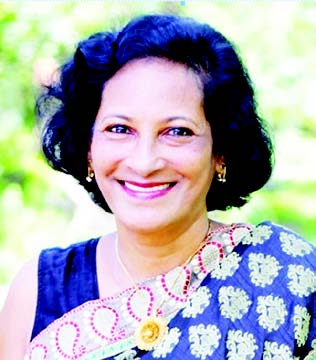
Sushila Sawant Mendes
Goa has a rich legacy of intellect. Each generation has produced men and women of calibre, independent ideas, and to a large extent society’s conscience keepers! Francis Luis Gomes and D. D. Kosambi dazzled the world. The past generation had a more difficult colonial environment and yet some stood tall. As 8th March (Women’s day) is fast approaching, it is pertinent to note that three girls defied the Goan ‘tigte’ principle (when the third girl is considered a bad omen by some).This myth was shattered when Filomena’s birth was welcomed after her sisters Claudina and Julia.
A lesser known fact is that three important stalwarts of Goa, Luis de Menezes Bragança, Antonio de Bragança Pereira and Tristãto de Bragança Cunha were the sons of three sisters of the Bragança family, Claudina, Julia and Filomena. The palatial Bragança house in Chandor is where it all began. With due respects to the residents of big palatial houses in Goa, the size of the house is not often proportionate to the size of the intellect of its residents, in most cases it proportionate to the family’s riches. This house was however was very different.
The patriarch, Francisco Xavier de Bragança and his wife Maria Ascença Margarida de Souza (of Calangute) had three girls, Claudina Stael, Julia Adelina and Filomena but there was no male lineage. The house was inherited by the eldest son-in-law Domingos Joveniano de Menezes (of Santacruz), the husband of Claudina Stael with the condition that the Bragança surname legacy would continue. He was a very eligible bachelor of his times as a lawyer and Municipal Judge of Quepem and later of Daman. Luis de Menezes Bragança, was their eldest son. His sister Maria unfortunately passed away at the tender age of ten. Luis de Menezes Bragança, thus inherited the house and the surname. On 15th January 2024, was the 175th birth anniversary of this legendary free thinker and journalist who is immortalized by our poet laureate Manohar Sardessai in his poem, Soglean poros vodlo tum (You are the greatest of them all). The last two lines portray the creativity of the poet himself:
Chandrachea chondrima re (O son of Chandor, it’s ever-rising moon)
Chandnem tujem fulta ozun (Your moonlight is forever fluorescent)
–and yet we all forget him year after year!
The second daughter of the house Julia Adelina married Antonio Felix Pereira (of Utorda), a member of the landed aristocratic gentry and thus the surname Bragança Pereira. Their eldest was Antonio Bernardo Bragança Pereira, author of Ethnography of Goa, Daman and Diu (published as a two volume edition in 1940 in Portuguese). The second volume has since been translated into English by Maria Aurora Couto. He was also a Juiz de Relação (Judge in the Court of Appeals) in Goa and Mozambique. He had refused to accept the office of the Presidente de Relaçao (Chief Justice) because it would have compromised his independence. He was fearless in his defence of Goans and Goan culture, often protesting against unfair sentences and offensive words of Portuguese officials. The other two boys José and Eufemiano worked in the Telegraph Department in Bombay and the Agriculture Department in Goa respectively. The daughter of Antonio Bernardo, Aida a student of Sorbonne University was married to the son of Luis de Menezes Bragança, Fernando Menezes Bragança. Aida was the person who took a lot of pains to restore the house in Chandor.
The third and the youngest daughter of F.X.Bragança, Filomena Bragança was married to Ligório de Cunha, a medical doctor from Cuelim, Cansaulim. He also edited, the newspaper O Nacionalista, published from 1904 to 1909. Menezes Bragança began his journalistic career writing on this paper that was edited by his uncle and later his own father in law. This marriage was blessed with six children who inherited the surname Bragança Cunha.
The eldest Vincente migrated to England. The second boy Francisco was the famous indologist who was the private secretary of Rabindranath Tagore. The third son was the famous T.B.Cunha, who was sent to study Electrical Engineering at Sorbonne University. He gave up his lucrative position as Faculty in Sorbonne and after fourteen years, returned back to Goa and formed the Goa Congress Committee which was affiliated to the Indian National Congress in 1928. His book, ’Denationalization of Goans’, is to date the subject of many an animated discussion. T.B.Cunha’s sister, Anna, married Luis de Menezes Bragança. The youngest Victoria married Sosthenes Cotta Carvlho, mother in law of the selfless social worker Inez Cotta Carvalho.
It was because of T.B.Cunha’s role in the freedom struggle that the occupants of the house Aida and her husband Fernando had to abandon their palatial house and live as refugees in Bangalore from 1947 till 1961. The house was in the hands of the loyal kunbi labourers who had served the house for many years. Aida fondly narrated that everything was intact when they returned after 14 years.
T.B.Cunha friend Shantaram Shringapuri, married the eldest daughter of Luis de Menezes Bragança, Olga. Luis de Menezes Bragança had his reservations of this inter-religious marriage. Perhaps it was more a problem of different cultures than different religions. Olga’s daughter’s Aquila and Geeta have been brought up in a Hindu culture and dress accordingly. They have both married two brothers of the Raje family and live in Porvorim. I recall how Claudio, the son of Aida, on the solemn occasion of his mother’s funeral, introduced his Hindu first cousins with a filial bond. This was the way Aida had brought up her children.
Luis de Menezes two daughters, Bertha and Beatrice always wore Khadi sarees and accompanied their maternal uncle (mother’s brother), T.B.Cunha. They played an active role in Goa’s freedom struggle. Bertha and her husband Antonio Furtado, continued T.B. Cunha’s paper, Free Goa, after his sudden death. She was also the President of the Communist Party of Goa. Beatriz obtained a doctorate in bio-chemistry and was a scientist of international repute at the Haffkine Institute, Bombay. She was the Cancer Research Director at the Tata Memorial Centre, Bombay and developed a cure against cobra venom.
It is an irony of fate that three sisters gave birth to three illustrious sons of Goa whose intellectual prowess made them great writers, journalists and a jurist who wrote his magnum opus on the Ethnography of Goa. All three lived in repressive colonial times but did not cow down to the shackles that attempted to bind them. T.B.Cunha paid the price of his writing with his sentence of rigorous imprisonment in Peniche and unfortunately never lived to see Goa’s liberation. Luis de Menezes Bragança’s Press where he published the newspaper Pracasha was vandalized, which led to his untimely death in the same year at the age of 60. Antonio Bragança Periera had to leave Goa and seek refuge in Bangalore. They withstood all their trials without complains. These three gentlemen never used their intelligence to make money for themselves or their families; in fact the family wealth was drained due to their political involvements. The flag of the house of the Bragança’s of Chandor was held high for posterity by the three girls of the family.
(The writer is a Professor, author, columnist & Best College Teacher Awardee)
